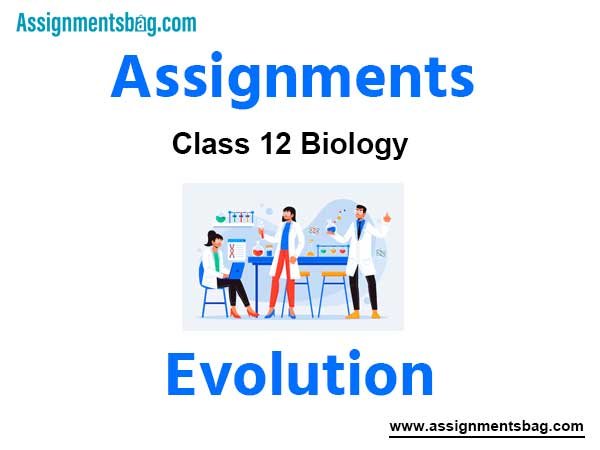Please refer to Assignments Class 12 Biology Evolution Chapter 7 with solved questions and answers. We have provided Class 12 Biology Assignments for all chapters on our website. These problems and solutions for Chapter 7 Evolution Class 12 Biology have been prepared as per the latest syllabus and books issued for the current academic year. Learn these solved important questions to get more marks in your class tests and examinations.
Evolution Assignments Class 12 Biology
Question. Stellar distance is measured in :
(a) Kilometer
(b) Light years
(c) Per socond
(d) None
Answer
B
Question. When more than one adaptive radiation appeared to have occurred in an isolated geographical area, it is called as :
(a) Divergent evolution
(b) Convergent evolution
(c) Parallel evolution
(d) Continental drift
Answer
B
Question. Out of the following which is an example of convergent evolution ?
(A) Eyes of octopus and mammals
(B) Flippers of penguins and Dolphins
(C) Sweet potato and potato
(a) A and C
(b) A and B
(c) B and C
(d) A, B and C
Answer
D
Question. What was the food habit of the original variety of Darwin’s finches from which many other varieties were developed ?2
(a) Seed eater
(b) Cactus eater
(c) Wood pecker
(d) Fruit eater
Answer
A
Question. What were two main key points of Darwinian theory of natural selection ?
(a) Branching descent
(b) Natural selection
(c) Fitness
(d) Both 1 and 2
Answer
D
Question. During evolution the first cellular form of life appeared before how many million years ?
(a) 2000
(b) 400
(c) 100
(d) 50
Answer
A
Question. The biggest dinosour, which appeared during evolution was :
(a) Thecodont
(b) Stegosaurus
(c) Triceratops
(d) Tyrannosaurus rex
Answer
D
Question. Mutations are :
(a) Random
(b) Directionless
(c) Both 1 and 2
(d) Always small
Answer
C
Question. Stanley Miller performed his experiment for explanation of origin of life, in which year ?
(a) 1953
(b) 1970
(c) 1870
(d) 1960
Answer
A
Question. In some animals, the same structures developed along different directions due to adaptions to different needs this is called as :
(a) Divergent evolution
(b) Convergent evolution
(c) Parallel evolution
(d) None of these
Answer
A
Question. Conventional religious literature tells us about the theory of special creation. Which of the following is/are included in the theory ?
(a) All living organisms that we see today were created as such
(b) The diversity was always the same since creation and will be the same in future.
(c) Earth is about 4000 year old.
(d) All of these
Answer
D
Question. Cranial capacity of homo erectus was about :
(a) 650-800 cc
(b) 1400 cc
(c) 900 cc
(d) 1600 cc
Answer
C
Question. Out of the following the theory of natural selection is based on certain observations, which are :
(A) Natural resources are limited
(B) Populations are stable in size except for seasonal fluctuations.
(C) Members of a population vary in characteristics even though they look superficially similar
(D) Most of variations are inherited
(a) A, C and D
(b) A, B, C and D
(c) B and C
(d) A, B and C
Answer
B
Question. The process of evolution of different species in a given geographical area starting from a point and literally radiating to other areas is called as :
(a) Convergent evolution
(b) Adaptive radiation
(c) Parallel evolution
(d) Continental drift
Answer
B
Question. Why, pouched mammals survived in Australia?
(a) Divergent evolution
(b) Continental drift
(c) Adaptive radiation
(d) Convergent evolution.
Answer
B
Question. Dinosours disappeared around :
(a) 200 million years ago
(b) 20 million years ago
(c) 65 million years ago
(d) 65 billion years ago
Answer
C
Question. The animals which evolved into the first amphibian that lived on both land and water, were :
(a) Jawless fish
(b) Lobefins
(c) Ichthyosours
(d) Shrew
Answer
B
Question. Darwin worked on, which island for explanation of natural selection ?
(a) Malay archipelago
(b) Galapagos
(c) Sumatra
(d) Port Blaier
Answer
B
Question. During natural selection which variety of Bistonbetularia was completely wiped out from England?
(a) White winged moth
(b) Dark winged moth
(c) Both of them
(d) None of them
Answer
D
Question. In which type of natural selection the peak gets higher and narrower ?
(a) Stabilising selection
(b) Directional selection
(c) Disruptive selection
(d) None of these
Answer
A
Question. Fore limbs of whale, bat, cheetah and human are example of :
(a) Analogous organs
(b) Homologous organs
(c) Homoplastic organs
(d) Vestigial organs
Answer
B
Question. Tasmanian Wolf, Tiger Cat, Sugar glider are example of :
(a) Convergent evolution
(b) Adaptive radiation
(c) Australian marsupials
(d) 2 and 3 both
Answer
D
Question. Which of the following statements is true ?
(a) During evolution, the rate of appearance of new form of organisms is linked to the life cycle/life span.
(b) The essence of Darwinian theory is natural selection.
(c) Fitness is based on characteristics which are inherited.
(d) All of them
Answer
D
Question. Hugo de vries called the single step large mutation as :
(a) Mutation
(b) Sports
(c) Micro evolution
(d) Saltation
Answer
D
Question. The industrial melanism phenomenon demonstrate:
(a) Gene mutation
(b) Genetic drift
(c) Natural selection
(d) Migration
Answer
C
Question. Which was absent in Miller’s experiment ?
(a) Vacuum pump
(b) Electrodes
(c) Condenser
(d) None
Answer
D
Question. During human evolution the body of which primitive ancestors covered by hairs and walk they walked gorilla and chimpanzee?
(a) Dryopithecus and Cromagnon man
(b) Dryopithecus and Ramapithecus
(c) Ramapithecus and Homo habilis
(d) Java man and Peking man
Answer
B
Question. Who proposed that the first form of life come from preexisting non- living molecules?
(a) Oparin and Haldane
(b) de Vries and Haldane
(c) Darwin and Lamarck
(d) Louis Pasteur and Miller
Answer
A
Question. Atmosphere of earth just before the origin of life consisted of
(a) water vapours, CH4, NH3 and oxygen.
(b) CO2, NH3, and CH2
(c) CH4, NH3, H2 and water vapours.
(d) CH4, O3, O2 and water vapours.
Answer
C
Question. Homologous organs show
(a) divergent evolution.
(b) convergent evolution.
(c) parallel evolution.
(d) both (b) and (c).
Answer
A
Question. Thorn of Bougainvillea and tendril of Cucurbita are examples of
(a) retrogressive evolution.
(b) analogous organs.
(c) homologous organs.
(d) vestigial organs.
Answer
C
Question. Darwin’s finches are a good example of
(a) convergent evolution
(b) industrial melanism
(c) connecting link
(d) adaptive radiation
Answer
D
Question. The Finches of Galapogas islands provide an evidence in favour of
(a) biogeographical evolution
(b) special creation
(c) evolution due to mutation
(d) retrogressive evolution
Answer
A
Question. Tasmanian Wolf is a marsupial while Wolf is a placental mammal. This shows
(a) convergent evolution
(b) divergent evolution
(c) inheritance of acquired characters
(d) None of these
Answer
A
Question. Single step large mutation leading to speciation is also called
(a) Founder effect
(b) saltation
(c) branching descent
(d) natural selection
Answer
B
Question. If the frequency of dominant allele is 60%, find out the percentage of heterozygous individuals in the population.
(a) 48%
(b) 50%
(c) 47%
(d) 45%
Answer
A
Question. Natural selection can lead to
(a) stabilization
(b) directional change
(c) disruption
(d) all of these
Answer
D
Question. Which one of the following was the first to stand erect ?
(a) Peking Man
(b) Australopithecus
(c) Java Man
(d) Cro-Magnon man
Answer
B
Statement Type Questions for Class 12 Biology Evolution
Question. Select the correct statement(s).
(i) Microbial experiment show the pre-existing advantageous mutations when selected will result in the observation of new phenotypes. Over few generation this would result in speciation.
(ii) Neanderthal fossils represent a human relative.
(iii) In 1938, a fish caught in South Africa happened to be a coelacanth (lobe fins) which was thought to be extinct. These animals evolved into the first amphibians living on both land and water.
(iv) Lichens can be used as water pollution indicators.
(v) Alfred Wallace, a naturalist, who worked in Malay Archaepelago (present Indonesia) had also come to similar conclusion on natural selection as reached by Darwinism.
(a) (i) and (ii)
(b) (i), (ii), (iii) and (v)
(c) (iii) and (iv)
(d) (iv) and (v)
Answer
B
Question. Which of the following is/are incorrect about neanderthal man?
(i) They had large brain around 900 c.c.
(ii) They lived in near east and central Asia between 100000-40000 years back.
(iii) They used hides to protect their body and buried their dead.
(iv) They had no religious feeling.
(a) All of these (b) None of these
(c) (i) and (iv) (d) (ii) and (iii)
Answer
C
Question. Read the following three statements (i – iii) and mark the right option.
(i) The thorns in Bougainvillea and tendrils in cucurbits represent divergent evolution.
(ii) The similarity in the eyes of Octopus and monkeys is the result of convergent evolution.
(iii) The potato and sweet potato are the examples of homology.
(a) (i) and (ii) correct
(b) (ii) and (iii) correct
(c) (i) and (iii) correct
(d) All (i) are correct.
Answer
A
Question. Which of the following is a correct?
(a) Homo erectus lived in east and central Asia and used hides to protect their bodies.
(b) Agriculture came around 18000 yrs back.
(c) The skull of modern human resembles more closely to baby chimpanzee than to adult chimpanzee.
(d) All of the above
Answer
C
Question. Which of the following statement is/are correct?
(i) Increase in melanized moths after industrialization in Great Britain is a proof for natural selection.
(ii) When more individuals of a population acquire a mean character value, it is called disruption.
(iii) Changes in allelic frequency in a population will lead to Hardy-Weinberg equilibrium.
(iv) Genetic drift changes the existing gene or allelic frequency in future generations.
(a) (ii) only
(b) (iv) only
(c) Both (i) and (iv)
(d) Both (i) and (iii)
Answer
C
Question. Given below are four statements (i – iv) each with one or two blanks. Select the option which correctly fills up the blanks in two out of four statements.
(i) Wings of butterfly and birds look alike and are the results of __(A)____, evolution.
(ii) Miller showed that CH4, H2, NH3 and ___(A)___, when exposed to electric discharge in a flask resulted in formation of ___(B)_____.
(iii) Vermiform appendix is a ___(A)____ organ and an __(B)_____ evidence of evolution.
(iv) According to Darwin, evolution took place due to ___(A)___ and ___(B)__ of the fittest.
(a) (iv) – (A) small variations, (B) survival, (i) – (A) convergent
(b) (i) – (A) convergent, (ii) – (A) oxygen, (B) nucleosides
(c) (ii) – (A) water vapour, (B) amino acids, (iii) – (A) rudimentary, (B) anatomical.
(d) (iii) – (A) vestigial, (B) anatomical, (iv) – (A)mutations, (B) multiplication
Answer
A
Question. Which of the following statements best describe the theory of natural selection?
(a) All organisms are equally suited to their environment.
(b) Random selection will determine which organisms survive.
(c) Organisms better adapted to their environment have greater reproductive success.
(d) Organisms that produce the most offspring are better suited to their environment.
Answer
C
Assertion/Reason Type Questions for Class 12 Biology Evolution
In the following questions, a statement of Assertion is followed by a statement of Reason.
(a) If both Assertion and Reason are true and the Reason is the correct explanation of the Assertion.
(b) If both Assertion and Reason are true but the Reason is not the correct explanation of the Assertion.
(c) If Assertion is true but Reason is false.
(d) If both Assertion and Reason are false.
Question. Assertion : Among the primates, chimpanzee is the closest relative of the present day humans.
Reason : The banding pattern in the autosome numbers 3 and 6 of man and chimpanzee is remarkably similar.
Answer
A
Question. Assertion : The earliest organisms that appeared on the earth were non-green and presumably anaerobes.
Reason : The first autotrophic organisms were the chemoautotrophs that never released oxygen.
Answer
B
Question. Assertion : The primitive atmosphere was reducing one i.e., without oxygen.
Reason : In the primitive atmosphere, oxygen was involved in forming ozone.
Answer
D
Matching Type Questions for Class 12 Biology Evolution
Question. Match the evolution concepts given in column-I with column-II and select the correct answer.
| Column – I | Column – II |
| A. Mutation | I. Change in population’s allele frequencies due to chance alone. |
| B. Gene flow | II. Differences in survival and reproduction among variant individuals. |
| C. Natural selection | III. Immigration, emigration change allele frequencies. |
| D. Genetic drift | IV. Source of new alleles. |
(a) A – I, B – II, C – III, D – IV
(b) A – IV, B – II, C – III, D – I
(c) A – III, B – I, C – IV, D – II
(d) A – IV, B – III, C – II, D – I
Answer
D
Question. Match column I (containing list of scientists) with column II (their contributions) and choose the correct option.
| Column-I (Name of the Scientist) | Column-II (Contributions) |
| A. Charles Darwin | I. Mutation theory |
| B. Lamarck | II. Germ plasm theory |
| C. Hugo de Vries | III. Philosophie Zoologique |
| D. Ernst Haeckel | IV. The Origin of species |
| E. August Weismann | V. Biogenetic law |
| VI. Essay on population |
(a) A – IV; B – III; C – I; D – V; E – II
(b) A – IV; B – III; C – V; D – I; E – VI
(c) A – IV; B – VI; C – V; D – III; E – I
(d) A – II; B – III; C – I; D – V; E – II
Answer
A
Question. Match column-I with column-II and select the correct option.
| Column-I | Column-II |
| A. Saltation | I. Darwin |
| B. Formation of life was preceded | II. Louis Pasteur |
| C. Reproductive | III. de Vries fitness |
| D. Life comes from | IV. Oparin and haldane pre-existing life |
(a) A – III, B – IV, C – I, D – II
(b) A – IV, B – III, C – II, D – I
(c) A – II, B – III, C – I, D – IV
(d) A – I, B – IV, C – III, D – II
Answer
A
Question. Which one of the following scientists name is correctly matched with the theory put forth by him?
(a) Weismann – Theory of continuity of Germplasm
(b) Pasteur – Inheritance of acquired characters
(c) De Vries – Natural selection
(d) Mendel – Theory of Pangenesis
Answer
A
Question. Which of the following pairs of terms is not related?
(a) Evolution – Natural selection
(b) Vestigial structure – Appendix
(c) Analogous structures – Butterfly wings
(d) Adaptive radiations – Vertebrates hearts or brains
Answer
D
Diagram Type Questions for Class 12 Biology Evolution
Question. The diversity within the wild bird species in the diagram below can best be explained by which process?
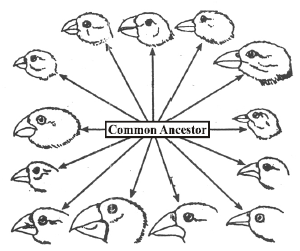
(a) Natural selection
(b) Ecological succession
(c) Adaptive radiation
(d) Both (a) and (c)
Answer
D
Question. Following is the diagrammatic representation of the operation of natural selection of different traits. Which of the following options correctly identifies all the three graphs A, B and C
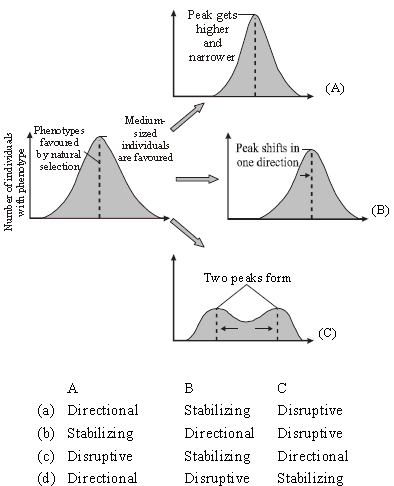
Answer
B
Question. The given figure shows an example of Tendril
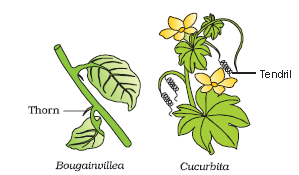
(a) homologous organs
(b) convergent evolution
(c) divergent evolution
(d) both (a) and (c)
Answer
D
Question. The following graph shows the range of variation among population members for a trait determined by multiple genes.

If this population is subject to stabilizing selection for several generations, which of the distributions (a -d) is most likely to result?

Answer
D
Question. The diagram below shows four species of birds that evolved from an ancestral species that had a small pointed beak. Today, all four species inhabit the same island.
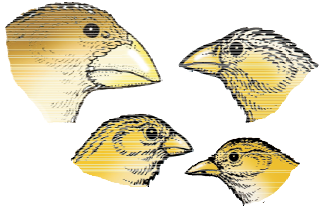
Which statement best explains the variation in the beaks of these four species?
(a) Over time, an abundance of seeds for food led to increased similarities between the species.
(b) Over time, an abundance of seeds for food led to increased differences between the species.
(c) Competition of limited food resources led to selection for similar traits.
(d) Competition for limited food resources led to selection for different traits.
Answer
B
Critical Thinking Type Questions for Class 12 Biology Evolution
Question. Evolution is
(a) progressive development of a race.
(b) history and development of a race along with variations.
(c) history of a race.
(d) development of a race.
Answer
C
Question. The first organisms were
(a) chemoautotrophs
(b) chemoheterotrophs
(c) autotrophs
(d) eukaryotes
Answer
C
Question. According to Oparin, which one of the following was not present in the primitive atmosphere of the earth?
(a) Methane
(b) Oxygen
(c) Hydrogen
(d) Water vapour
Answer
C
Question. The eye of octopus and eye of cat show different patterns of structure, yet they perform similar function. This is an example of
(a) Homologous organs that have evolved due to divergent evolution.
(b) Analogous organs that have evolved due to convergent evolution.
(c) Analogous organs that have evolved due to divergent evolution.
(d) Homologous organs that have evolved due to convergent evolution.
Answer
C
Question. Archaeopteryx is known as missing connecting link because it is a fossil and shows the characters of
(a) fishes and amphibians.
(b) birds and reptiles.
(c) reptiles and mammals.
(d) chordates and nonchordates.
Answer
C
Question. The concept of chemical evolution is based on
(a) possible origin of life by combination of chemicals under suitable environmental conditions.
(b) crystallization of chemicals.
(c) interaction of water, air and clay under intense heat.
(d) effect of solar radiation on chemicals.
Answer
C
Question. Stabilizing selection favours
(a) both extreme forms of a tract.
(b) intermediate forms of a tract.
(c) environmental differences.
(d) one extreme form over the other extreme form and over intermediates forms of a tract.
Answer
C
Question. Genetic drift in a new colony is known as the
(a) natural selection
(b) Founder effect
(c) branching descent
(d) saltation
Answer
C
Question. The finches of Galapagos islands provide an evidence in favour of
(a) evolution due to mutation
(b) retrogressive evolution
(c) biogeographical evolution
(d) special creation
Answer
C
Question. What was the most significant trend in the evolution of modern man (Homo sapiens) from his ancestors?
(a) Shortening of jaws
(b) Binocular vision
(c) Increasing cranial capacity
(d) Upright posture.
Answer
C
Question. The tendency of population to remain in genetic equilibrium may be disturbed by
(a) random mating
(b) lack of immigration
(c) lack of mutations
(d) lack of random mating
Answer
C
Question. What is meant by the term Darwin fitness?
(a) The ability to survive and reproduce
(b) High aggressiveness
(c) Healthy appearance
(d) Physical straight
Answer
C
Question. According to Hardy-Weinberg principle, allele and genotype frequencies in a population will remain constant from generation to generation in the absence of other evolutionary influences. It makes several assumptions which were given below.
i. Random Mating
ii. Sexual Reproduction
iii. Non-overlapping Generations
iv. Occurrence of Natural Selection
v. Small size of population
Identify two assumptions which do not met for a population to reach Hardy-Weinberg Equilibrium?
(a) iv and v
(b) ii and iv
(c) iii, iv and v
(d) i, ii and iii
Answer
C
